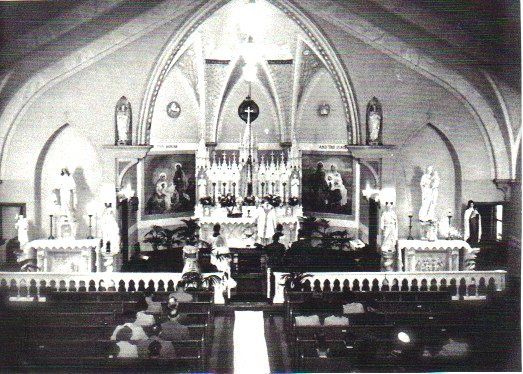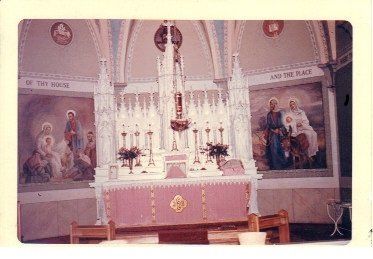History of St. Joseph's Church

The story of Saint Joseph Parish began with Fr. Burke who was later ordained Bishop of Cheyenne, Wyoming. He was the first priest to take a notable interest in the Catholic people of the Manhattan area. He and his assistant from St. Mary’s in Joliet, Fr. James Greene, attended sick calls and administered other sacraments to the little community from about 1884. Later, Fr. Burke divided his parish boundary and made the southern half, Sacred Heart Parish in Joliet, with Manhattan as a mission. St. Joseph Church was built in 1889 at its present location on North Street with the first Mass said on December 28, 1891. In 1895, a twenty-seven foot addition was built to the small wooden frame building, with a belfry in which a 2500-pound bell was hung.
After Fr. Burke, Fr. Christopher Foster and his assistant priest continued to make the long and arduous trip between Joliet and Manhattan to serve on a regular basis the spiritual needs of his congregation. As Fr. Foster grew older and got to know the people of Manhattan, he decided to spend the rest of his days among his country people. In 1905, Fr. Foster gave up Sacred Heart Parish and made his headquarters at Manhattan. Widely known as a brilliant orator and lecturer on the “Power of Music" he was loved and respected by one and all.
As the parish grew, land was acquired for a graveyard on what was then known as Joliet Road and the new cemetery was dedicated by Bishop McGavick, then Auxiliary Bishop of Chicago on October 12, 1910. Martin Bergan, cemetery trustee for 30 years took great pride in his cemetery and always had grass and hedges neatly trimmed, and the graves well kept.
Six months after the cemetery dedication in 1911, Fr. Foster was laid to rest. Because his charities were often larger than his purse, when Fr. Foster died he left about $5000 in debts behind him. This the good people of Manhattan promptly paid off and had enough left to erect a fine stone over his grave. The good pastor was faithful to his flock all his life, and his parishioners have kept his memory green ever since.
Fr. Foster was followed by the Fr. Patrick McGee who served from 1911-1922.
In 1922, Fr. James Kearns became pastor of St. Joseph's. It was during his 7 year term that the present church building was erected in 1926. St. Joseph's is one of the few combination buildings that does not look like a cowshed alongside of a barn, or a factory. Complete with a campanile on one side and a Norman Gothic tower on the other, the convent and the first school were harmoniously blended into the rest of the building so as to look like the transept of a cathedral.
The original building housed the church, the three classrooms of the school on the first floor behind the altar and a convent on the second floor for the Sisters of St. Francis of Mary Immaculate, who taught in the school. The school which opened September 8, 1925 had a staff of three nuns for 40 students. The cost of this new building was $87,000 and all but $20,000 of the debt was paid off by the tireless young pastor before he was transferred to St. Ethelreda’s in Chicago in 1928. Besides raising the money to pay for the building from his parishioners and friends, Fr. Kearns did much of the labor on the building, driving a team of horses behind the scraper to help excavate the foundation.
Fr. Broderick succeeded Fr. Kearns in 1928. Fr. Broderick started a tradition of having chicken dinners at the parish which is still being talked about. The farmers in Manhattan have always been famous for their dinners, and have never failed to rise to the occasion to celebrate their Catholic faith and Christian fraternity.
Fr. Frank Glynn came to Manhattan as the financial storm clouds were gathering over the country in 1929. Whereas in good times it was possible to payoff $10,000 a year from the debt, now it became a struggle to make ends meet and to pay the interest. During these times, the price structure for farm products collapsed, and then, to make matters worse, drought and cinch bugs ate up the crops. Many people lost their homes, and were unable to support their parish church. In his wisdom, Fr. Kearns saved in the “seven years of plenty" like Joseph in the Old Testament. This allowed Fr. Glynn to save enough and pay off debt to make it possible to weather the storms of the seven years of famine.
On March 19, 1937, the Feast of St. Joseph, patron saint of the parish, Fr. John Gallery was appointed to the Parish. It was mentioned at the time that it would be a good omen for a priest to be given charge of a parish on the feast day of its patron. Fr. Gallery left Manhattan in 1943 to become Chaplain in the Navy during World War II.
The new pastor, Reverend John Nellis became the one with the longest tenure as pastor. Fr. Nellis came to St. Joe’s in 1943 and tended to the spiritual needs of the people until 1959. Fr. Nellis appointed Franklin Forsythe as cemetery sexton in 1949. Franklin and his sons maintained the cemetery plots and grass for the next 15 years until an outside service was hired to mow the lawns. Franklin has faithfully served the Parish as cemetery sexton 66 years and has generously donated his time and efforts.
In June 1959, Reverend Lloyd Bowden became pastor. He was responsible for purchasing a convent house for the Franciscan nuns who staffed the school.
The tenth pastor, Fr. Francis Rausch had a great love for Catholic education, he viewed the establishment of a separate school building as an important goal and aspiration of the parish. In record time, the building that housed the school and gym was erected.
Fr. Joseph Shimanek served as pastor of St. Joseph’s from 1964 until 1973. During his tenure, the parishioners took on the task of renovating the church that had been built fifty years before. What had taken $87,000 to build now took $120,000 to renovate. Once again, parishioners sacrificed significantly to complete the necessary restructuring and rebuilding. The church was rededicated October 13, 1973. In the early 1990s St. Joseph’s Catholic Church was air-conditioned.
Fr. Edwin Joyce, arrived in Manhattan in June 1973 and remained until 1978. Fr. James O’Donoughue came to the parish in July 1978 and was pastor for one year. He was followed by Fr. James Frederick, who served as pastor for the next three years.
Fr. Gerald Tivy, the 15th pastor of St. Joseph’s served during a time when both the town and parish community experienced a slow but steady growth. In 1985, the parish purchased additional land for a new cemetery on Route 52. The new St. Joseph Guardian Angel Cemetery was dedicated and blessed by Bishop Roger Kaffer on September 28, 1991.
Rev. Edward J. O'Malley became the parish’s 16th pastor in June 1988. Fr. O'Malley oversaw many physical changes to the parish while providing for the spiritual needs of its congregants. He saw to the renovation of the Bell in the church tower, first cast in 1865. With significant growth in the parish, a major renovation was begun in 1999. When completed the seating capacity in the Church doubled while the simplicity and beauty of the original structure remained. The classroom and library became seating areas on each side of the altar. The expansion and renovation costs were over one million dollars. A new gym was dedicated on September 25, 2006 and named after Fr. O’Malley. Fr. Edward J. O’Malley suffered a stroke in November 2004 and retired in 2005, but once he recovered he remained on as Pastor Emeritus.
Fr. John T. McGeean came to St. Joseph Parish in June, 2005. He was assigned as Administrator of our Parish while Fr. O’Malley was on sick leave. He officially became the pastor in October 2005 upon Fr. O’Malley’s retirement. Fr. McGeean was a great historian and story teller. Fr. McGeean loved visiting with the school children and sharing history stories. His faithfulness and jovial communications were an inspiration to many of our young people. In June of 2013 Fr. McGeean retired.
Fr. McGeean was followed by Fr. John Lindsey, in 2013. Fr. Lindsey, worked with parishioners to breathe new life into the parish. Fr. John reintroduced the Saint Joseph table, began a ministry for campus environment renewal and restarted Youth Ministry to build a foundation for the parish future.
In the summer of 2013, Fr. Lindsey discerned that the parish needed more office and gathering space, thus “The House of Prayer, House of Gathering” Campaign was begun. The intent was to purchase a house for the parish priests, convert the old rectory into a permanent parish center and build a prayer chapel that would always be open to parishioners. So, the good hearted and forward thinking parishioners decided to purchase the house west of the rectory to establish a new home for their present and future pastors. In the beginning of 2015 after the pastor moved out of the old rectory, a process began to convert the old rectory office into five offices and three meeting rooms. Also, it was proposed and approved that the Parish would build a new Adoration Chapel adjoining the newly created parish offices. The Adoration Chapel was dedicated in July of 2017. This is a hub of prayer for the parish and is open 24 hours a day, seven days a week.
Father Mike McMahon was appointed as Pastor July 2023 and installed September 9th by Bishop Ronald Hicks.
Our Parish is proud of the vocations that have come from our church. Fr. Dan Hoehn, Brother Kevin Fitzgerald, Fr. Scott Huggins all attended Saint Joseph school and they and their families are faithful members of the Parish. In addition Fr. Mark Bernhard recently completed his studies for the Diocese of Joliet and was ordained to the priesthood in 2017. May God bless our Church by raising up dedicated and generous leaders from our families and friends who will serve as Sisters, Priests, Brothers, Deacons and Lay leaders.

